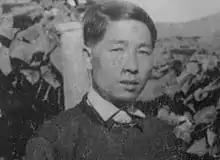Shong Lue Yang
Shong Lue Yang (RPA: Soob Lwj Yaj [ʃɔ́ŋ lɨ̂ jâ], Pahawh: 𖬌𖬤𖬵 𖬘𖬲𖬞 𖬖𖬲𖬤, [ʃɔ́ŋ lɨ̂ jâ];[1] September 15, 1929 – February, 1971) was a Hmong spiritual leader and creator of the Pahawh script, a semi-syllabary for writing dialects of the Hmong language, as well as the Khmu language.
Shong Lue Yang | |
|---|---|
𖬌𖬤𖬵 𖬘𖬲𖬞 𖬖𖬲𖬤 | |
 Soob Lwj Yaj | |
| Pronunciation | [ʃɔ́ŋ lɨ̂ jâ] |
| Born | September 15, 1929 in the village of Fi Tong, near the city of Nong Het, Laos |
| Died | 1971 (aged 41–42) assassinated in the village of Nam Chia |
| Known for | Creator of both Pahawh Hmong and Pahawh Khmu writing systems, and the Hmong ChaoFa Flag |
Coming under suspicion by opposing forces, he was assassinated in February 1971, during the Laotian Civil War. He is honored as the "Mother of Writing" (Niam Ntawv) among the Hmong people. Like the Cherokee Sequoyah of the early 19th century in Indian Territory (now United States), Shong Lue Yang is one of the few people from a pre-literate society known in history to have independently created an effective writing system.[2]
Biography
Born in the village of Fi Tong (Huồi tụ), Vietnam, near the city of Nong Het, Laos, Yang grew up without learning to read or write, although he likely observed various writing systems.[3] For much of his life, he subsisted as a farmer and basket maker.
Beginning in 1959, he reportedly had a series of divine revelations, during which he was taught the Pahawh script by a set of male twins. In his visions, he was instructed to teach the script to the Hmong and Khmu peoples. He believed that the groups who accepted the writing system would flourish and escape the hardships of the period, that resulted in the Laotian Civil War. Afterward, Yang assumed the title of "Savior of the Common People" (Theej Kaj Pej Xeem), and began teaching the script and his message of redemption across Laos.[4] He is one of the few people from a pre-literate society known to have independently created an effective writing system. Another is Sequoyah (c.1770-1843), a Cherokee polymath who developed a syllabary for his language; he lived in what became Tennessee and Oklahoma in the United States.[2]
Following initial successes, including the building of a school in the village of Fi Kha, Yang was targeted by communist forces for his association with General Vang Pao and his troops. Later, he fell under suspicion by both Hmong groups who supported the Royal Lao Government (including members of Vang Pao's army) and by those Hmong who supported the communist Pathet Lao. General Vang Pao offered a reward and ordered the assassination of Shong Lue Yang, who was killed in February 1971 by Nos Toom Yang in the village of Nam Chia. By then Shong Lue Yang had completed his final version of the Pahawh Hmong script.
Nos Toom Yang never received the promised reward of 3,000,000.00 Lao-Kip (approximately $158.96 during the year 1974; adjusted for inflation (as of 14 February 2011), the reward ranges between $340.14 to $377.96). In 1974, while attempting to collect the bribe from General Vang Pao in Thailand, where many Laotians went as refugees, Nos Toom Yang was killed by Thai officials as ordered by the general. Nos Toom Yang was handcuffed, blindfolded, and thrown into the Mekong River.
Shong Lue Yang's writing system survived and was republished in many books. One of these books is Mother of Writing: The Origin and Development of a Hmong Messianic Script (1990), by American William A. Smalley.
Notes
- Smalley, William Allen, Chia Koua Vang (Txiaj Kuam Vaj
 ), and Gnia Yee Yang (Nyiaj Yig Yaj
), and Gnia Yee Yang (Nyiaj Yig Yaj  ). Mother of Writing: The Origin and Development of a Hmong Messianic Script. University of Chicago Press, May 15, 1990. 1. Retrieved from Google Books on March 23, 2012. ISBN 0226762866, 9780226762869.
). Mother of Writing: The Origin and Development of a Hmong Messianic Script. University of Chicago Press, May 15, 1990. 1. Retrieved from Google Books on March 23, 2012. ISBN 0226762866, 9780226762869. - Wilford, John Noble (22 June 2009). "Carvings From Cherokee Script's Dawn". New York Times. Retrieved 23 June 2009.
- Smalley 1990:86–90
- Smalley 1990:16–25
References
- Smalley, William A.; Vang, Chia Koua; Yang, Gnia Yee (1990). Mother of Writing: The Origin and Development of a Hmong Messianic Script. Chicago: University of Chicago Press. ISBN 978-0226762876.
- Pahawh Hmong alphabet, at Omniglot
- http://www.motherofwriting.com
- Life of Shong Lue Yang: Hmong 'Mother of Writing' (Keeb Kwm Soob Lwj Yaj: Hmoob 'Niam Ntawv'). Libraries digital conservancy